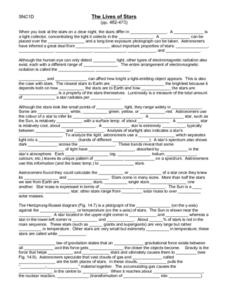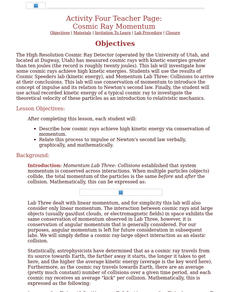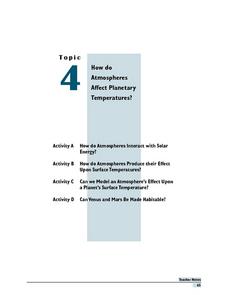Curated OER
Forces And Energy
Learners investigate the atom and how it is formed. They conduct research using a variety of resources and then construct a model of the atom. Then students have class discussion. The instructional activity includes background...
Curated OER
The Connection Between Pigment and Light Colors
Students learn the procedure for mixing secondary colors from primary pigments and observe the results of mixing two primary colors.
Curated OER
Gaining Familiarity with Magnetism
Young scholars discuss their perceptions of magnetism and explore the background ideas of magnetism.
Curated OER
Wavelength and Energy
Pupils using a rope and other materials explore wavelengths and frequency. If time permits, more experiments can be tried.
Curated OER
It's All In The Surface: The Effects Of Color & Texture On The Ability Of A Surface To Absorb Solar Energy
Ninth graders examine how dark surfaces absorb more light than light surfaces. They perform an experiment that compares various surfaces abilities to absorb heat, then record and analyze the results.
Curated OER
You, Me and UV
Students explore the validity of claims of UV protection. Students research UV rays and the cancer danger presented by these rays. Working in groups, they perform tests on sunglass and sunscreen products to determine if their claim of UV...
Curated OER
Einstein's Big Idea
Students investigate the meaning of c2 in E=mc2 by measuring the energy delivered by an object falling at different velocities. They state that kinetic energy is the energy of an object in motion. Students illustrate how kinetic energy...
Curated OER
The Lives of Stars
In this stars activity, students review what makes up a star, how astronomers learn about stars, and the different types of stars including low mass and high mass stars. This activity has 62 fill in the blank statements.
Curated OER
Life of Thomas Edison
Students research the life of Thomas Edison. For this Thomas Edison lesson, students explore major life events of Thomas Edison. Students investigate the inventions of Thomas Edison. Students discover how various fields of study...
Curated OER
Eyes in the Sky
Students complete a unit on orbiting spacecraft designed to study astronomical objects. They conduct Internet research on NASA missions, use a satellite dish to downlink information, and construct and launch a rocket out of paper and tape.
Curated OER
Seeing The Sun In A New Light
High schoolers examine the observation of "coronal holes," by x-rays, also about related fast streams and moderate magnetic storms that recur at 27 day intervals. They study NASA'S great observatories.
Curated OER
(S-4) The Magnetic Sun
Young scholars explore magnetism and magnetic phenomena on the Sun.
Curated OER
Cosmic Ray Momentum
Students describe how cosmic rays achieve high kinetic energy via conservation of momentum.
Curated OER
Electricity - Lesson Plan
Tenth graders should explain some basic properties of electricity and know how electricity is produced. They should also explain the electrical components that make up electric circuits.
Curated OER
Gravity Launch
Students use an online interactive to launch a rocket from earth. They have control over the angle and thrust of the rocket to discover the relationship between the two.
Curated OER
The Universe in a Different Light
Pupils become aware of some of the objects studied in, and concepts associated with, high-energy astronomy. They do this by participating in card games that teach and review these concepts.
Curated OER
How Did That Get in My Lunch?
Middle schoolers view "The Danger Zone" to learn about food poisoning and the bacterial causes and prevention. Students look at slides, use a worksheet, "Microbial Bugs"and the internet to identify and learn about each bacterium.
Curated OER
Day and Night
Students using experiments try to demonstrate how observations can be affected by the cycles of night and day.
Curated OER
Color Recognition
Young scholars envision how space observatories make use of monochromatic filters to collect data on the color of objects in space. They see the actual colors of objects when they are in monochromatic light.
Curated OER
Twisted Vision
Students explain polarization vision and why some animals have it while others do not. They examine the reasons why it would be helpful for marine organisms to have polarized light.
Curated OER
How Do Atmospheres Affet Planetary Temperatures?
Students perform a literature search and use reputable research resources in order to find the surface temperature of different planets in our solar system. They speculate about the observed and unobserved factors. Then brainstorming is...
Curated OER
Coefficient of Kinetic Friction and Surface Area
Young scholars investigate coefficient of friction with respect to surface area and applied force in contact with the sliding force.
Curated OER
Good Vibrations
Students demonstrate sound waves and make changes in the waves
resulting in changes in pitch. Students associate changes in pitch in various "musical instruments"with size and shape and the sound waves they produce.
Curated OER
Falling
Students should describe the path that the motion would take as well as what might begin or stop the motion. The common characteristic of all the motions that students have experienced directly is that one or more forces are acting on...
Other popular searches
- Magnets and Electromagnets
- Electromagnets Motors
- Science Electromagnets
- How to Make Electromagnets
- Building Electromagnets
- Electromagnets Relays
- Physics Electromagnets
- Electromagnets 5 E's

























